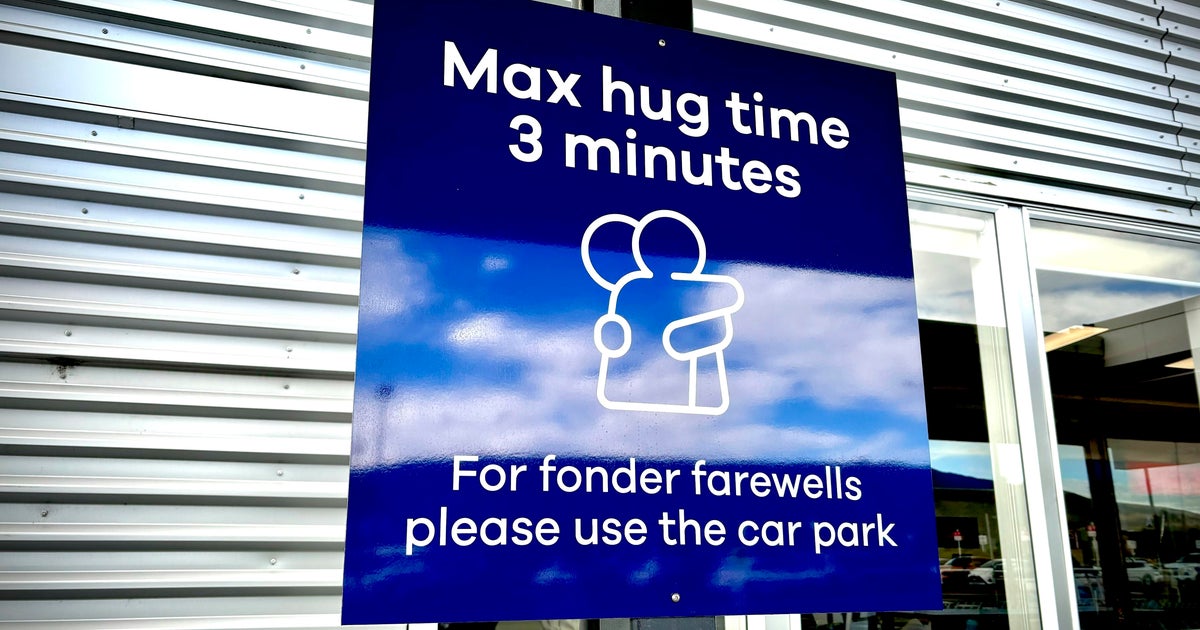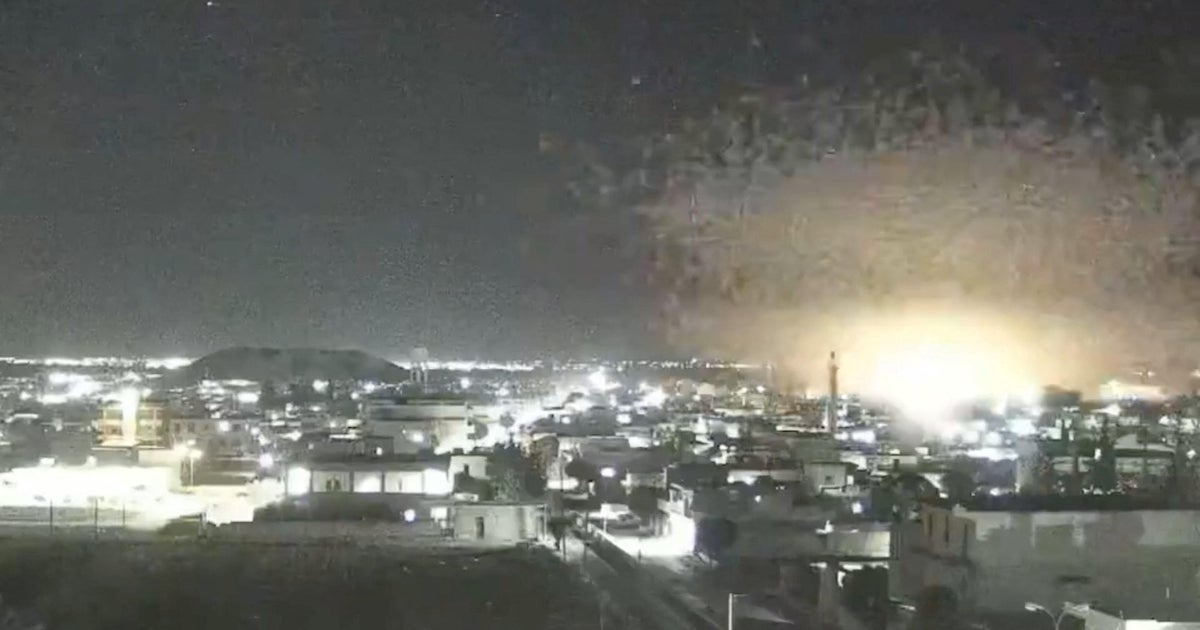CBS News
New Zealand airport with 3-minute cap on farewell hugs “surprised how much global interest” there’s been

Wellington — A New Zealand airport has imposed a three-minute limit on farewell hugs, sparking a worldwide debate over how long to cling on for a cuddle. Bosses at the international airport in the southern city of Dunedin say they were surprised by the viral response to their new rule in the car drop-off zone.
“To keep things moving smoothly, we’ve installed new signage, including the ‘Max hug time 3 minutes’ sign,” said airport chief executive Daniel De Bono. “It’s our way of being a little quirky and reminding people that the drop-off zone is for quick farewells.”
“And don’t worry,” added De Bono, “just a 20-second hug is enough to release oxytocin and serotonin, the happy hormones that boost well-being, so three minutes is plenty of time to say goodbye and get your dose of happiness.”
Sarah Soper/AP
People who want a longer hug can use the parking lot, where the first 15 minutes are free, he added.
The hug restriction made headlines worldwide — and prompted a divided online response.
“I’m just glad there’s no minimum hug time. A ‘see ya soon’ suffices,” one woman commented on the airport’s Facebook page.
“Hug Police!? This is just weird! Hugs are proven to have many benefits not to mention mental health,” said another poster.
The small airport, which was used by fewer than 1 million passengers last year, said it had imposed the hug time limit in September, with little initial reaction.
“We have just been surprised how much global interest there has been,” said the airport’s marketing and communications executive, Sarah Soper.
CBS News
Hurricane Helene’s damage, related expenses in North Carolina shattering records, estimated at $53 billion

Raleigh, N.C. — The catastrophic flooding and destruction caused by Hurricane Helene in western North Carolina likely caused at least a record $53 billion in damages and recovery needs, Gov. Roy Cooper’s administration said Wednesday.
The state budget office generated the preliminary figure for direct or indirect damages and potential investments to prevent similar destruction in future storms.
Cooper told reporters the state’s previous record for storm damage was $17 billion from Hurricane Florence, which struck eastern North Carolina in 2018.
“It is no exaggeration to describe Helene as the deadliest and most damaging storm ever to hit North Carolina,” Cooper said while unveiling his request to the General Assembly for $3.9 billion to help pay for repairs and revitalization. He called it a “down payment on western North Carolina’s future.”
North Carolina state officials have reported 96 deaths from Helene, which brought historic levels of rain and flooding to the mountains in late September.
The storm and its aftermath caused 1,400 landslides and damaged over 160 water and sewer systems, at least 6,000 miles of roads, more than 1,000 bridges and culverts and an estimated 126,000 homes, the budget office said. Some 220,000 households are expected to apply for federal assistance.
“This jaw-dropping damage figure reminds us that we are very much on the front end of this recovery effort,” the Democratic governor said.
The report with Cooper’s spending request was released the day before the Republican-controlled legislature planned to meet for a one-day session to advance additional Helene recovery legislation.
Lawmakers unanimously approved two weeks ago a $273 million package that also included language to provide flexibility to state agencies, displaced residents and officials running elections in 25 western counties. Thirty-nine of the state’s 100 counties are within the federally declared disaster area.
State government coffers include several billon dollars that can be accessed for future recovery spending. Almost $4.5 billion is in the state’s savings reserve alone.
Legislative leaders hadn’t disclosed as of late Wednesday afternoon specifics about what they would attempt to pass Thursday. Lawmakers were still reviewing Cooper’s request that they received Tuesday, according to Lauren Horsch, a spokesperson for Senate leader Phil Berger. Any legislation is unlikely to be the full package presented by Cooper and State Budget Director Kristin Walker. After Thursday, legislators are expected to return to Raleigh on Nov. 19.
The damage report projects $48.8 billion in direct or indirect damages, along with $4.8 billion of anticipated mitigation expenses. The budget office estimates the federal government will cover $13.6 billion, with private and other sources covering $6.3 billion.
Most of the losses won’t ever be recovered, Walker said.
The private-source share of expenses likely will be relatively low because so few homeowners and farmers in the disaster areas had flood or crop insurance. Close to 93% of homes with flood damage verified by the Federal Emergency Management Agency lacked flood insurance, the report said.
Cooper’s request includes $475 million for a two-phase recovery program for businesses in the hardest-hit areas, with grants from $1,500 to $50,000 in the first phase and up to $75,000 in the second phase.
Other highlights include $289 million in matching funds to access federal money to repair utilities and debris removal; $225 million for grants to farmers for uninsured losses; and $100 million for public school and community college capital needs.
Cooper also wants $325 million to help homeowners and renters with rebuilding and minor repairs immediately while a larger program dependent on federal funds is implemented. It took nearly two years for Washington to send community development block grant funding for home repairs after Florence and Hurricane Matthew in 2016, the report said.
Wednesday’s request also seeks $175 million to cover remaining Matthew and Florence home repairs being made through the block grant program. Cooper’s administration attributes the shortfall to rising construction costs, labor shortages, the COVID-19 pandemic and a congressional appropriation that was roughly half of what the state requested.
The fiscal gap prompted Berger and another leading Senate Republican to put out a news release Wednesday criticizing the $175 million request and its timing, calling them yet another sign of poor management by the state Office of Recovery and Resiliency. The senators said an oversight committee would investigate the matter next month.
CBS News
U.S.-allied Kurds in Syria say 12 killed in strikes as Turkey responds to attack on state-run defense firm

Turkey launched airstrikes late Wednesday in Kurdish-held parts of Syria and Iraq in retaliation for a deadly attack at a state-owned defense manufacturer in Ankara that saw at least two attackers kill four people and wound more than a dozen others.
The Turkish government blamed the separatist Kurdistan Workers’ Party (PKK) for what President Recep Tayyip Erdogan called a “nefarious” attack on the Turkish Aerospace Industries headquarters outside the capital.
Video verified by CBS News Confirmed showed damage to electrical infrastructure in Kobani and Qamishli, the de-facto capital of the semi-autonomous region controlled by Kurdish-majority forces in northeast Syria.
The Syrian Democratic Forces (SDF) — who were key U.S. allies in the war against ISIS in the region — said Thursday that 12 people were killed, including two children, and 25 others wounded in widespread Turkish air and artillery strikes. Turkey’s defense ministry said it struck 47 “terrorist targets” in Syria and Iraq.
Social Media/via REUTERS
SDF commander General Mazlum Abdi condemned the Turkish strikes as indiscriminate, saying they had hit civilian infrastructure, including health centers, in northeast Syria.
“We have repeatedly shown our readiness for dialogue. Meanwhile, we affirm that our forces are ready to defend our people and land,” Abdi said in a post on X.
Some 900 U.S. forces remain in the region as part of the international coalition against ISIS, and the SDF has long been America’s primary partner on the ground in northeast Syria. Neither the U.S. Defense Department nor its Central Command had commented on the attack in Ankara, or on Turkey’s retaliatory strikes, by Thursday morning.
Ankara considers the U.S.-backed SDF and its civilian body, the YPG, to be directly linked to the PKK, which has waged a decades-long insurgency in Turkey.
The PKK, long designated a terrorist organization by Turkey and the U.S., is nominally headquartered in the Qandil mountains of northern Iraq. Turkey regularly strikes the region.
No group has claimed responsibility for Wednesday’s attack in Ankara, which came at a time of renewed talks between the Turkish government and the PKK’s leader, Abdullah Ocalan, who has been imprisoned in Turkey for more than two decades.
On Thursday, Ocalan’s nephew Omer, a member of Turkey’s parliament, conveyed a message from the PKK leader suggesting he was prepared to end the violent conflict that has raged since the mid-1980s.
Erdogan ally and Nationalist Movement Party leader Devlet Bahceli had earlier invited Ocalan to address parliament, and said the 75-year-old could be paroled in exchange for disbanding the PKK.
CBS News
Sneak peek: The Strange Shooting of Alex Pennig

Watch CBS News
Be the first to know
Get browser notifications for breaking news, live events, and exclusive reporting.










